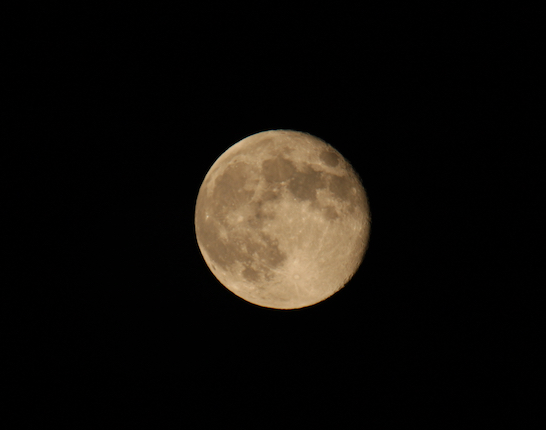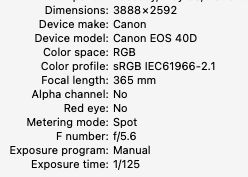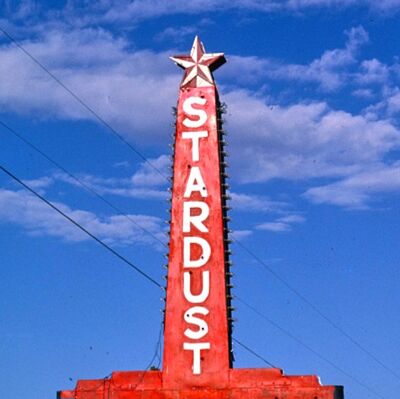How to capture the moon
May 30, 2023 09:15:33 #
May 30, 2023 09:20:48 #
A really, really large net and a really, really long rope?
Sorry, the devil made me write that.
Sorry, the devil made me write that.

May 30, 2023 09:22:45 #
May 30, 2023 09:22:58 #
Use spot metering on the moon, daylight setting.
Averaging looks at the WHOLE scene, tries to expose for the "dark" and turns the moon into a solid white ball.
Tripod helps.
Averaging looks at the WHOLE scene, tries to expose for the "dark" and turns the moon into a solid white ball.
Tripod helps.
May 30, 2023 09:24:25 #
May 30, 2023 09:32:01 #
To me tripod is a must, I don't have a remote trigger so set shutter at 2-second delay to minimize shake from tripping, often set exposure -1 or -2 until find correct metering. I also use spot or meter factors in dark sky giving that white ball.
By the way, welcome to UHH.
By the way, welcome to UHH.
May 30, 2023 09:43:59 #
May 30, 2023 09:46:39 #
Rhare wrote:
I can never capture the moon as it looks. Any suggestions?
Remember it is daylight on the moon. Start with standard daylight settings.
May 30, 2023 09:46:58 #
Rhare wrote:
I can never capture the moon as it looks. Any suggestions?
I don’t understand why this so important to some people. NASA does a great job - from above the atmosphere.
May 30, 2023 09:58:07 #
Rhare wrote:
I can never capture the moon as it looks. Any suggestions?
I start at F5.6 at 125 and tweak it from there - Not the best pic of the moon, but is shows how to grab the moon so it doesn't look like a "spotlight"...


May 30, 2023 09:58:08 #
rehess wrote:
I don’t understand why this so important to some people. NASA does a great job - from above the atmosphere.
Maybe because they want their own photographs?
May 30, 2023 10:02:00 #
Longshadow wrote:
Maybe because they want their own photographs?
Thank you
 You beat me to it... it's amazing how on a photographers forum when someone asks for help, they get garbage comments.
You beat me to it... it's amazing how on a photographers forum when someone asks for help, they get garbage comments.May 30, 2023 10:02:44 #
Rhare wrote:
I can never capture the moon as it looks. Any suggestions?
Looney 11 rule: "For astronomical photos of the Moon's surface, set aperture to f/11 and shutter speed to the [reciprocal of the] ISO film speed [or ISO setting]."
You don't need a tripod. Just use a shutter speed you can hand hold.
May 30, 2023 10:02:51 #
May 30, 2023 10:06:08 #
larryepage
Loc: North Texas area
Rhare wrote:
I can never capture the moon as it looks. Any suggestions?
There was quite a bit of discussion of this topic three or four years ago. A search should bring up some of those topics.
There are a few things to remember about the moon. The first is that it is a subject without much contrast, especially the full moon. The second is that it is illuminated by the same sunlight that illuminates the earth at noon on a very clear day. The third is that there are a surprising number of variables, most related to the photographer's location and how high the moon is in the sky. We know from the Apollo lunar landings that moon rock is gray, and that the surface appears a very pale orange if you are actually there.
Photographing the moon is best accomplushed as a Manual operation...across the board...including no Auto ISO and no Auto WB. You may be able to auto focus on the limb (the edge) of the moon, but you may need to focus manually, as well.
I have found that, as a general rule, the moon high in the sky needs about one stop more than a sunlit exposure on earth, most of the time. Da
An example would be 1/400 at ISO 400 at f/11. Daylight White Balance. If the moon is near the horizon, you will need one or two stops of additional exposure.
These are all starting points. You will need to bracket or experiment to get the proper exposure at your shooting location and time. Also...make sure that your camera is not set to a portrait mode or some other low contrast mode. There's not much contrast to start with, and you don't need to be reducing it any.
If you are capturing raw files, this is not a time to be exposing to the right. You need to be in the "meat" of the response curve in order to get the image information you will need.
So...Manual everything, be prepared to experiment, and when you think you have it all figured out, bracket anyway.
Good luck and have fun.
If you want to reply, then register here. Registration is free and your account is created instantly, so you can post right away.




